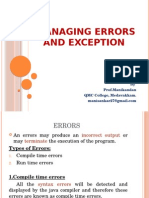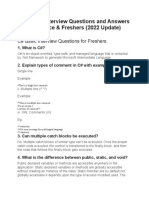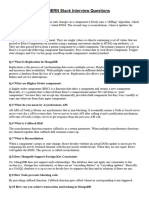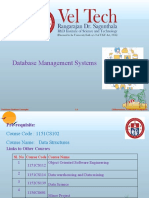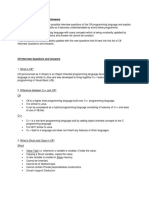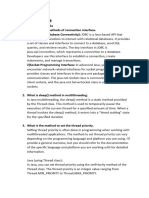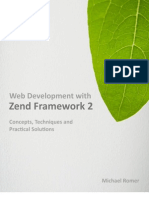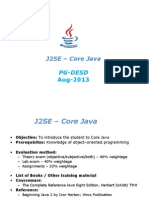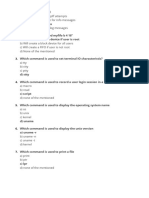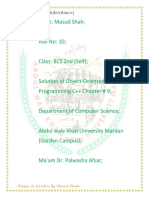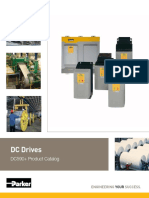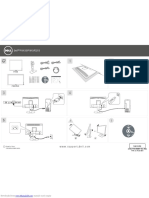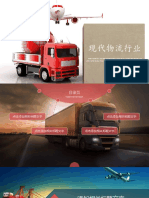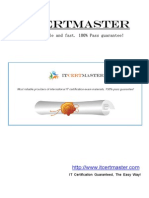L4 Backend Design
Uploaded by
ngenderanjL4 Backend Design
Uploaded by
ngenderanjMODULE: DELEVOP BACKEND DESIGN
LEVEL 4 DELEVOP BACKEND DESIGN NOTES
UNIT 1: Analyze System Backend
1.1 DEFINITION OF TERMINOLOGIES
Backend:
The back end refers to parts of a computer application or a program's code that allow it to operate and that
cannot be accessed by a user. Most data and operating syntax are stored and accessed in the back end of a
computer system
frontend focuses on those aspects your users can see. Conversely, the backend is everything that makes
your application function.
system
A system is a group of related things that work together as a whole. These things can be real or imaginary.
Systems can be man-made things like a car engine or natural things like a star system. Systems can also
be concepts made by people to organize ideas. A subsystem is a system that is part of some larger system.
server
A server is a software or hardware device that accepts and responds to requests made over a network.
In computing, a server is a computer that is capable of providing a service, data, or resources from
hardware and software to other devices or users.
Operating System (OS)
An Operating System (OS) is an interface between a computer user and computer hardware. An
operating system is a software that performs all the basic tasks like file management, memory
management, process management, handling input and output, and controlling peripheral devices such as
disk drives and printers.
database
A database is an organized collection of structured information, or data, typically stored electronically in
a computer system. A database is usually controlled by a database management system (DBMS).
System Development Life Cycle (SDLC)
The system development life cycle (SDLC) is a complex project management model that encompasses
system or software creation from its initial idea to its finalized deployment and maintenance. SDLC
comprises seven different stages: planning, analysis, design, development, testing, implementation, and
maintenance.
APIs
APIs(application programming interface )are mechanisms that enable two software components to
communicate with each other using a set of definitions and protocols. For example, the weather bureau's
software system contains daily weather data. The weather app on your phone “talks” to this system via
APIs and shows you daily weather updates on your phone
JavaScript Object Notation (JSON
JavaScript Object Notation (JSON) is a standard text-based format for representing structured data
based on JavaScript object syntax. It is commonly used for transmitting data in web applications (e.g.,
sending some data from the server to the client, so it can be displayed on a web page, or vice versa).
Framework
A framework, or software framework, is a platform that provides a foundation for developing software
applications. Think of it as a template of a working program that can be selectively modified by adding
code.
Examples of frameworks:
Bootstrap
Angular js
React
Flutter
React native
UML(Unified Modelling Language)
Unified Modeling Language (UML) is a standardized modeling language used in software
engineering to visualize, specify, construct, and document the artifacts of a system. UML
provides a set of graphical notation techniques to create abstract models of systems, referred
to as UML diagrams. These diagrams are used to represent different aspects of a system and
its components.
FURPS(Functionality, Usability, Reliability, Performance, and Supportability)
FURPS is an acronym used in software engineering to categorize different aspects of software
quality attributes. It stands for Functionality, Usability, Reliability, Performance, and
Supportability. Each of these categories encompasses a set of characteristics that help in
evaluating and specifying the quality of a software system. Here's a detailed breakdown:
Functionality
Features: The presence of necessary features and capabilities in the software.
Capabilities: What the system can do; its range of functions and services.
Generality: The breadth of the system's applicability.
Security: The ability of the system to protect information and data from unauthorized
access and modification.
Usability
Human Factors: The system’s ease of use and learnability.
Aesthetics: The visual appeal and design of the user interface.
Consistency: Uniformity in design and behavior across different parts of the system.
Documentation: The quality and completeness of user manuals, help guides, and other
documentation.
Reliability
Availability: The readiness of the system for usage.
Failure Frequency: The rate at which the system fails.
Predictability: The consistency of the system’s performance under varying conditions.
Recoverability: The ability to recover quickly from failures and errors.
Performance
Speed: How fast the system performs under a given workload.
Efficiency: The system’s resource usage relative to its performance.
Scalability: The system’s capacity to handle increased loads.
Response Time: The time it takes for the system to respond to user inputs or requests.
Supportability
Testability: The ease with which the system can be tested for defects.
Extensibility: The ease of adding new features and capabilities to the system.
Adaptability: The system’s ability to adapt to new environments or requirements.
Maintainability: How easily the system can be maintained, including fixing bugs and
making updates.
Compatibility: The ability of the system to operate in various environments and with
other systems.
1.2: system development life cycle
The system development life cycle or SDLC is a project management model used to outline,
design, develop, test, and deploy an information system or software product. In other words, it
defines the necessary steps needed to take a project from the idea or concept stage to the actual
deployment and further maintenance.
SDLC represents a multitude of complex models used in software development. On a practical
level, SDLC is a general methodology that covers different step-by-step processes needed to
create a high-quality software product.
If you’re a developer or project manager, an understanding of the most up-to-date SDLC
methodologies is a powerful tool. It empowers you to speed up the development process, cut
costs, leverage the full creative capacity of your team, and more.
7 Stages of the System Development Life Cycle
There are seven separate SDLC stages. Each of them requires different specialists and diverse
skills for successful project completion. Modern SDLC processes have become increasingly
complex and interdisciplinary.
That is why it’s highly recommended that project managers engage a dedicated team of
professional developers. Such a team will possess enough expertise and knowledge to launch a
first-class software product that perfectly corresponds to all your expectations, needs, and goals.
Let’s take a look at the core tasks associated with each of the different phases of the development
life cycle.
1. Planning Stage – What Are the Existing Problems?
Planning is one of the core phases of SDLC. It acts as the foundation of the whole SDLC
scheme and paves the way for the successful execution of upcoming steps and, ultimately, a
successful project launch.
In this stage, the problem or pain the software targets is clearly defined. First, developers and
other team members outline objectives for the system and draw a rough plan of how the system
will work. Then, they may make use of predictive analysis and AI simulation tools at this stage
to test the early-stage validity of an idea. This analysis helps project managers build a picture of
the long-term resources required to develop a solution, potential market uptake, and which
obstacles might arise.
At its core, the planning process helps identify how a specific problem can be solved with a
certain software solution. Crucially, the planning stage involves analysis of the resources and
costs needed to complete the project, as well as estimating the overall price of the software
developed.
Finally, the planning process clearly defines the outline of system development. The project
manager will set deadlines and time frames for each phase of the software development life
cycle, ensuring the product is presented to the market in time.
2. Analysis Stage – What Do We Want?
Once the planning is done, it’s time to switch to the research and analysis stage.
In this step, you incorporate more specific data for your new system. This includes the first
system prototype drafts, market research, and an evaluation of competitors.
To successfully complete the analysis and put together all the critical information for a certain
project, developers should do the following:
Generate the system requirements. A Software Requirement Specification
(SRS) document will be created at this stage. Your DevOps team should have a high
degree of input in determining the functional and network requirements of the upcoming
project.
Evaluate existing prototypes. Different prototypes should be evaluated to identify those
with the greatest potential.
Conduct market research. Market research is essential to define the pains and needs of
end-consumers. In recent years, automated NLP (natural language processing) research
has been undertaken to glean insights from customer reviews and feedback at scale.
Set concrete goals. Goals are set and allocated to the stages of the system development
life cycle. Often, these will correspond to the implementation of specific features.
Most of the information generated at this stage will be contained in the SRS. This document
shapes the strict regulations for the project and specifies the exact software model you will
eventually implement.
3. Design Stage – What Will the Finished Project Look Like?
The next stage of a system development project is design and prototyping.
This process is an essential precursor to development. It is often incorrectly equated with the
actual development process but is rather an extensive prototyping stage.
This step of the system development life cycle can significantly eliminate the time needed to
develop the software. It involves outlining the following:
The system interface
Databases
Core software features (including architecture like microservices)
User interface and usability
Network and its requirement
As a rule, these features help to finalize the SRS document as well as create the first prototype of
the software to get the overall idea of how it should look like.
Prototyping tools, which now offer extensive automation and AI features, significantly
streamline this stage. They are used for the fast creation of multiple early-stage working
prototypes, which can then be evaluated. AI monitoring tools ensure that best practices are
rigorously adhered to.
4. Development Stage – Let’s Create the System
In the development stage of SDLC, the system creation process produces a working solution.
Developers write code and build the app according to the finalized requirements and
specification documents.
This stage includes both front and back-end development. DevOps engineers are essential for
allocating self-service resources to developers to streamline the process of testing and rollout, for
which CI/CD is typically employed.
This phase of the system development life cycle is often split into different sub-stages, especially
if a microservice or miniservice architecture, in which development is broken into separate
modules, is chosen.
Developers will typically use multiple tools, programming environments, and languages (C++,
PHP, Python, and others), all of which will comply with the project specifications and
requirements outlined in the SRS document.
5. Testing Stage – Is It the Exact One We Needed?
The testing stage ensures the application’s features work correctly and coherently and fulfill user
objectives and expectations.
This process involves detecting the possible bugs, defects, and errors, searching for
vulnerabilities, etc., and can sometimes take up even more time compared to the app-building
stage.
There are various approaches to testing, and you will likely adopt a mix of methods during this
phase. Behavior-driven development, which uses testing outcomes based on plain language to
include non-developers in the process, has become increasingly popular.
Similarly, automated and cloud-based platforms, which simulate testing environments, take a
significant amount of manual time out of this stage of the system development life cycle.
Selenium, a browser testing tool, is one popular example of such a platform.
6. Integration and Implementation Stage – How Will We Use It?
Once the product is ready to go, it’s time to make it available to its end users and deploy it to the
production environment.
At this stage, the software undergoes final testing through the training or pre-production
environment, after which it’s ready for presentation on the market.
It is important that you have contingencies in place when the product is first released to market
should any unforeseen issues arise. Microservices architecture, for example, makes it easy to
toggle features on and off. And you will likely have multiple rollback protocols. A canary release
(to a limited number of users) may be utilized if necessary.
7. Maintenance Stage – Let’s Make the Improvements
The last but not least important stage of the SDLC process is the maintenance stage, where the
software is already being used by end-users.
During the first couple of months, developers might face problems that weren’t detected during
initial testing, so they should immediately react to the reported issues and implement the changes
needed for the software’s stable and convenient usage.
This is particularly important for large systems, which usually are more difficult to test in the
debugging stage.
Automated monitoring tools, which continuously evaluate performance and uptime and detect
errors, can assist developers with ongoing quality assurance. This is also known as
“instrumentation.”
Basic 6 SDLC Methodologies
Now that you know the basic SDLC phases and why each of them is important, it’s time to dive
into the core methodologies of the system development life cycle.
These are the approaches that can help you to deliver a specific software model with unique
characteristics and features. Most developers and project managers opt for one of
these 6 approaches. Hybrid models are also popular.
Let’s discuss the major differences and similarities of each.
Waterfall Model
The Waterfall Model is one of the earliest and most traditional methodologies used in software
development. It is a linear and sequential approach where each phase of the software
development process must be completed before the next phase begins. This model is often used
for projects with well-defined requirements and low uncertainty. Here is an in-depth look at the
Waterfall Model:
Phases of the Waterfall Model
1. Requirements Analysis:
o In this initial phase, all possible requirements of the system to be developed are
captured and documented in a requirement specification document. This phase
involves understanding what the stakeholders need from the system.
o Output: Requirements Specification Document.
2. System Design:
o Based on the requirements gathered, the system design is created. This phase
focuses on how to build the system, including the hardware and system
architecture, as well as software architecture and detailed design.
o Output: System Design Documents.
3. Implementation (Coding):
o The system is developed in small units, which are then integrated in the next
phase. Each unit is coded and tested for functionality. This phase involves actual
programming and converting design documents into executable code.
o Output: Source Code.
4. Integration and Testing:
o The developed units are integrated into a complete system. The system is then
tested as a whole to ensure it meets the specified requirements. This phase
involves various types of testing such as unit testing, integration testing, system
testing, and acceptance testing.
o Output: Test Reports, Integrated System.
5. Deployment:
o Once testing is completed successfully, the system is deployed to the production
environment where it will be used by the end users. This phase may involve
installation, configuration, and setup of the system.
o Output: Deployed System, User Manuals.
6. Maintenance:
o After deployment, the system enters the maintenance phase. This includes fixing
any issues that arise, making minor updates, and performing necessary
improvements. Maintenance continues for the lifetime of the system.
o Output: Updated System, Maintenance Reports.
DIAGRAM OF WATERFAL MODELS
Advantages of the Waterfall Model
Simple and Easy to Understand: The linear structure makes it easy to follow and
understand.
Structured Approach: Clear, well-defined stages with specific deliverables and review
processes.
Easy to Manage: Each phase has specific deliverables and a review process, making the
management straightforward.
Documentation: Extensive documentation at each stage helps in maintaining a clear
record of the development process.
Disadvantages of the Waterfall Model
Inflexible to Changes: Changes in requirements are difficult and costly to incorporate
once the process has moved to later stages.
No Overlapping Phases: Each phase must be completed before the next begins, leading
to longer project timelines.
Late Testing: Testing is done at the end, which means that issues found can be very
costly to fix.
Risk Management: Not ideal for projects with high uncertainty or complex
requirements.
When to Use the Waterfall Model
Stable Requirements: Best suited for projects where requirements are well-understood
and unlikely to change.
Short Projects: Suitable for projects with short timelines and clear objectives.
Regulatory Compliance: Ideal for projects that require thorough documentation and a
structured development approach to meet regulatory standards.
Iterative Model
The Iterative Model is a software development methodology that involves developing a system
through repeated cycles (iterations) and incrementally refining it based on feedback and learning
from each cycle. Unlike the Waterfall Model, which follows a linear sequence, the Iterative
Model allows for revisiting and improving different aspects of the system at various stages of
development.
Key Characteristics of the Iterative Model
1. Incremental Development: The system is developed and delivered in small, manageable
parts or increments.
2. Repetition: Each iteration involves going through the development cycle multiple times.
3. Feedback Loop: Continuous feedback from users and stakeholders is used to refine and
improve the system.
4. Risk Management: Early iterations help identify and mitigate risks early in the
development process.
5. Flexibility: Adaptable to changes in requirements and scope as the project progresses.
Phases of the Iterative Model
The Iterative Model typically follows a series of phases in each iteration, similar to the
traditional software development life cycle but with repeated cycles. Here is a typical workflow:
1. Planning:
o Define the objectives, scope, and schedule for the iteration. Identify the specific
functionality to be developed in this cycle.
o Output: Iteration Plan.
2. Analysis and Design:
o Analyze requirements and create a design for the functionality to be implemented
in the iteration. This may involve refining the overall system architecture.
o Output: Design Documents, Updated Requirements.
3. Implementation:
o Develop the code for the features and functions identified for the iteration. This
involves programming, unit testing, and integration.
o Output: Source Code, Unit Test Results.
4. Testing:
o : Perform testing on the integrated increment to ensure it meets the specified
requirements and is free of defects. This includes system testing, integration
testing, and user acceptance testing.
o Output: Test Reports, Feedback.
5. Evaluation:
o Evaluate the iteration results, gather feedback from stakeholders, and review
progress against objectives. Identify changes or improvements for the next
iteration.
o Output: Evaluation Reports, Stakeholder Feedback.
6. Deployment (Optional):
o Deploy the iteration’s increment to a production or user environment if it adds
significant value.
o Output: Deployed Increment (if applicable).
Advantages of the Iterative Model
Flexibility: Easily accommodates changes in requirements and scope throughout the
development process.
Risk Reduction: Early iterations help identify and address risks, improving the quality
and reliability of the final product.
Feedback Integration: Continuous feedback from stakeholders ensures the system meets
user needs and expectations.
Incremental Delivery: Provides partial functionality early, which can be beneficial for
stakeholder engagement and early value realization.
Learning and Improvement: Each iteration allows for learning from previous cycles,
leading to continuous improvement.
Disadvantages of the Iterative Model
Complex Management: Requires careful planning and management to ensure iterations
are effectively integrated and coordinated.
Resource Intensive: Iterative cycles can be resource-intensive, requiring sustained effort
from the development team.
Scope Creep: The flexibility to accommodate changes can lead to scope creep if not
properly managed.
Increased Documentation: Maintaining comprehensive documentation for each iteration
can be challenging.
When to Use the Iterative Model
Complex Projects: Suitable for projects with complex requirements and high
uncertainty.
Evolving Requirements: Ideal for projects where requirements are expected to change
or evolve over time.
Risk Management: Beneficial for projects where early risk identification and mitigation
are crucial.
Stakeholder Feedback: Projects that require continuous stakeholder involvement and
feedback.
Spiral Model
The Spiral Model is a software development process model that combines elements of both
iterative development and prototyping models. It was introduced by Barry Boehm in 1986 and is
particularly well-suited for projects with high risk and uncertainty. Here are the key features and
characteristics of the Spiral Model:
1. Iterative Approach: The development process in the Spiral Model progresses through a
series of iterations, called spirals. Each spiral represents a phase in the software
development process.
2. Risk Management: One of the central features of the Spiral Model is its focus on risk
assessment and mitigation. Each spiral begins with a risk analysis phase, where potential
risks are identified and strategies are developed to manage them.
3. Phases: The typical phases in the Spiral Model include:
o Objective setting: Specific objectives for the iteration are defined.
o Risk assessment and reduction: Risks are identified and strategies are
formulated to mitigate them.
o Development and validation: The software is developed and tested.
o Planning: Plans for the next iteration are prepared.
4. Flexibility: The Spiral Model is highly flexible, allowing for changes to be made at any
point in the development process. This is particularly useful when requirements are not
well understood initially or when they may change over time.
5. Prototyping: Prototyping is often used in the Spiral Model to provide a better
understanding of the system requirements and to identify potential risks.
6. Phased Development: Each iteration in the Spiral Model results in a deliverable product
increment, which means that the software is developed and delivered in smaller chunks
compared to traditional waterfall models.
7. Applicability: The Spiral Model is particularly suitable for large, complex projects where
uncertainty and risks are high. It is also useful for projects where stakeholders are not
fully aware of their needs upfront, allowing for iterative refinement of requirements.
8. Documentation: The Spiral Model emphasizes the importance of documentation
throughout the process, ensuring that all decisions and risks are well-documented and
traceable.
The Spiral model best fits large projects where the risk of issues arising is high. Changes are
passed through the different SDLC phases again and again in a so-called “spiral” motion.
It enables regular incorporation of feedback, which significantly reduces the time and costs
required to implement changes.
V-Model
he V-Shaped Model, also known as the Verification and Validation model, is an extension of the
Waterfall Model. It emphasizes a more rigorous and systematic approach to testing. In the V-
Shaped Model, each phase of the development lifecycle has a corresponding testing phase,
forming a V-shape when diagrammed. This model ensures that verification and validation
activities occur early and in parallel with each development phase.
Key Characteristics of the V-Shaped Model
1. Sequential Phases: Like the Waterfall Model, it follows a sequential path, but with an added
focus on testing.
2. Corresponding Testing Phases: Each development phase has a directly associated testing phase.
3. Verification and Validation: Ensures that each step of the development process is verified
against requirements and validated with actual results.
4. Emphasis on Quality: Focuses on quality assurance by integrating testing into every stage of the
development lifecycle.
Phases of the V-Shaped Model
Verification Phases
1. Requirements Analysis:
o Collect and document all system requirements. Establish what the system should do.
o Output: Requirements Specification Document.
o Testing Phase: Acceptance Testing Planning.
o Goal: Validate requirements against user needs and plan tests that will verify the final
system against these requirements.
2. System Design:
o Define the overall system architecture and design.
o Output: System Design Document.
o Testing Phase: System Testing Planning.
o Goal: Plan system-level tests to verify the system design.
3. High-Level (Architectural) Design:
o Break down the system into modules or components, defining their relationships and
interfaces.
o Output: High-Level Design Document.
o Testing Phase: Integration Testing Planning.
o Goal: Plan integration tests to verify the interaction between modules.
4. Low-Level (Detailed) Design:
o Detailed design of each module or component, specifying the internal logic and
algorithms.
o Output: Low-Level Design Document.
o Testing Phase: Unit Testing Planning.
o Goal: Plan unit tests to verify the functionality of individual components.
5. Implementation (Coding):
o Actual coding of the modules/components based on the detailed design.
o Output: Source Code.
o Testing Phase: Code Reviews, Static Testing.
o Goal: Ensure code meets design specifications and is free of basic errors.
Validation Phases
1. Unit Testing:
o Test individual units or components for correctness.
o Input: Low-Level Design Document, Source Code.
o Goal: Verify that each component performs as designed.
2. Integration Testing:
o Test the interaction between integrated units or components.
o Input: High-Level Design Document, Integrated Modules.
o Goal: Verify that modules or components interact correctly.
3. System Testing:
o Test the entire system as a whole to ensure it meets specified requirements.
o Input: System Design Document, Fully Integrated System.
o Goal: Validate the system against the requirements specification.
4. Acceptance Testing:
o Test the system in the user environment to ensure it meets user needs and
requirements.
o Input: Requirements Specification Document, System Under Test.
o Goal: Obtain user approval and ensure the system is ready for deployment.
Advantages of the V-Shaped Model
Simple and Easy to Use: Clear, structured approach with defined stages and deliverables.
Testing Integration: Early integration of testing phases improves defect detection and reduces
risks.
Documentation: Extensive documentation at each stage supports traceability and accountability.
Quality Assurance: Rigorous testing ensures a high-quality final product.
Disadvantages of the V-Shaped Model
Inflexibility: Like the Waterfall Model, it is difficult to accommodate changes once a phase is
completed.
Late Testing: Despite early planning, actual testing happens after coding, which may delay defect
detection.
Resource Intensive: Requires thorough documentation and planning for each phase and
corresponding test.
When to Use the V-Shaped Model
Stable Requirements: Best suited for projects with well-understood and stable requirements.
Small to Medium Projects: Ideal for projects with manageable complexity and scope.
High-Quality Standards: Suitable for projects where quality assurance is critical and thorough
testing is essential.
Agile Model
The meaning of Agile is swift or versatile."Agile process model" refers to a software
development approach based on iterative development. Agile methods break tasks into
smaller iterations, or parts do not directly involve long term planning. The project scope
and requirements are laid down at the beginning of the development process. Plans
regarding the number of iterations, the duration and the scope of each iteration are
clearly defined in advance.
Each iteration is considered as a short time "frame" in the Agile process model, which
typically lasts from one to four weeks. The division of the entire project into smaller
parts helps to minimize the project risk and to reduce the overall project delivery time
requirements. Each iteration involves a team working through a full software
development life cycle including planning, requirements analysis, design, coding, and
testing before a working product is demonstrated to the client.
Phases of Agile Model:
Following are the phases in the Agile model are as follows:
Requirements gathering
Design the requirements
Construction/ iteration
Testing/ Quality assurance
Deployment
Feedback
1. Requirements gathering: In this phase, you must define the requirements. You should explain
business opportunities and plan the time and effort needed to build the project. Based on this information,
you can evaluate technical and economic feasibility.
2. Design the requirements: When you have identified the project, work with stakeholders to define
requirements. You can use the user flow diagram or the high-level UML diagram to show the work of new
features and show how it will apply to your existing system.
3. Construction/ iteration: When the team defines the requirements, the work begins. Designers and
developers start working on their project, which aims to deploy a working product. The product will
undergo various stages of improvement, so it includes simple, minimal functionality.
4. Testing: In this phase, the Quality Assurance team examines the product's performance and looks for
the bug.
5. Deployment: In this phase, the team issues a product for the user's work environment.
6. Feedback: After releasing the product, the last step is feedback. In this, the team receives feedback
about the product and works through the feedback.
Benefits of SDLC
Having covered the major SDLC methodologies offered by software development companies,
let’s now review whether they are actually worth employing. Here are the benefits that the
system development life cycle provides:
Comprehensive overview of system specifications, resources, timeline, and the project
goals
Clear guidelines for developers
Each stage of the development process is tested and monitored
Control over large and complex projects
Detailed software testing
Process flexibility
Lower costs and strict time frames for product delivery
Enhanced teamwork, collaboration, and shared understanding
Possible Drawbacks of SDLC
Just like any other software development approach, each SDLC model has its drawbacks:
Increased time and costs for the project development if a complex model is required
All details need to be specified in advance
SDLC models can be restrictive
A high volume of documentation which can slow down projects
Requires many different specialists
Client involvement is usually high
Testing might be too complicated for certain development teams
1.3 Backend development Technologies
Python and Its frameworks
Starting with Python – a general purpose and dynamically interpreted programming language that has
been gaining huge momentum in the development world. Due to its flexibility and versatile functionality,
Python can unleash its full power as a web development stack in machine learning, AI, scientific research,
and other emerging fields
What are Frameworks in Python?
Django
Django is a popular open-source full-stack Python framework that includes all the
necessary Python features by default. It follows the DRY principle - Don’t Repeat
Yourself. Django uses an ORM or object-relational mapper to map objects to database
tables. This helps you use the object-oriented paradigm to manipulate data from a
database. The main databases that Django works on are Oracle, MySQL, PostgreSQL,
and SQLite. It can also work on other databases using third-party drivers. Here are some
more exemplary features of the Django web framework:
URL routing
Authentication
Template engine
Database schema migrations
A plethora of ready-to-use libraries
More secure as compared to other frameworks
Web2Py
Web2Py is another popular open-source and full-stack Python framework. It is platform-
independent, which means that it can run on all the popular operating systems. Furthermore, it
simplifies the web application development process through its own web-based IDE that includes
a code editor, a debugger, and one-click deployment. Here are some more features of the
Web2Py framework:
No prerequisites for installation and configuration
Can read multiple protocols
Support different platforms
Data security
Error tracking mechanism
Role-based access control
Backward compatibility
Flask
Flask is a micro-framework for Python. It is lightweight and easily adaptable to suit a
developer’s needs. The Flask framework comes under the BSD license and requires the
Werzeug WSGI toolkit and Jinja2 templates. Here are some of the main features of the Flask
framework:
Fast debugger
Jinja2 templating
Unicode-based
Built-in development server
HTTP request handling
WSGI compliance
Integrated support for unit testing
RESTful request dispatching
Secure cookies support
Ability to plug any ORM
Bottle
Bottle is a micro-framework for prototyping and building simple personal applications. It
was originally meant for building APIs and is considered by developers as one of the
finest Python web frameworks. It also allows developers to work closely with the
hardware to build small and simplistic personal use apps. Here are some of the main
features of the Bottle framework:
A built-in development server
Access to form data, cookies, headers, file uploads, cookies, headers, etc.
Includes plugin support for different databases.
Routing
Templating
Abstraction layer over the WSGI standard
CherryPy
CherryPy is an open-source Python framework that follows a minimalist approach for building
web applications. Released in 2002, it is one of the oldest Python frameworks still popular today.
Unlike other frameworks, you don't need to install the apache server to run CherryPy. With
CherryPy, you can build web applications the same way you would an object-oriented program.
The best thing about this framework is that it allows you to use any type of technology for
creating templates and data access. Here are some more features of using the CherryPy
framework:
A flexible plugin system
Built-in support for profiling, coverage, and testing
Can run on different platforms
Simplifies running multiple HTTP servers at once
Encoding
Authentication
Java and Its frameworks
The greatest advantage of Java backend development is making the code run
seamlessly in different environments like Linux, macOS, Windows, etc. The best
use case of Java, as one of the oldest programming languages, is enterprise
application development. Fintech solutions, and embedded systems. And since it
is object-oriented, you can easily create reusable code and modular programs.
Example frameworks of java:
Spring
Play
Vaadin
JavaScript and Its frameworks
This programming language is particularly unique for its usefulness in
both frontend and backend development. Such capabilities have made
JavaScript a well-recognized language over the years that offers superior
interoperability, seamless third-party integration with multiple resources, dynamic
interfaces, and so on.
Front-End Frameworks
1. REACT: React.js is an efficient and flexible JavaScript library for building user interfaces
created by Facebook. Technically, React is a JS library, but it is often discussed as a web
framework and is compared to any other open source JavaScript framework.
React makes it easy to create interactive user interfaces because it has predictable JavaScript code that is
easy to debug. Furthermore, it provides a REACT component system where blocks of JavaScript code can
be written once and reused repeatedly in different parts of the application or even other applications.
React.js stands out as the go-to JavaScript framework right now. Created and supported by Facebook, it
provides a straightforward and component-based method for creating user interfaces. Its user-friendly
nature makes it a top pick for both newcomers and seasoned developers.
2. ANGULAR: AngularJS is a popular enterprise-level JavaScript framework used for developing large
and complex business applications. It is an open-source web framework created by Google and supported
by both Google and Microsoft.
3.VUE: Vue.js is a progressive framework for building user interfaces. It is an up-and-coming framework
that helps developers in integrating with other libraries and existing projects. It has an ecosystem of
libraries that allow developers to create complex and solid single-page applications.
BACK-END FRAMEWORKS
EXPRESS
Express.js is a flexible, minimalistic, lightweight, and well-supported framework for Node.js applications.
It is likely the most popular framework for server-side Node.js applications. Express provides a wide
range of HTTP utilities, as well as high-performance speed. It is great for developing a simple, single-
page application that can handle multiple requests at the same time.
NEXT.JS
Next.js is a minimalistic framework that allows a a JavaScript developer to create a server-side rendering
and static web applications using React.js. It is one of the newest and hottest frameworks that takes pride
in its ease of use. Many of the problems developers experience while building applications using React.js
are solved using Next.js. It has many important features included “out of the box,” and makes
development a JavaScript breeze.
PHP and Its frameworks
There is no doubt about the effectiveness of PHP development services as it has consistently
remained a popular language since 1997. HTML codes are the building block of this
backend programming language, and hence, it is a perfect choice for handling
dynamic content, databases, and eCommerce sites. It is also very simple and
straightforward to use, leading to a shorter learning curve for developers.
Php frameworks:
Laravel
Cogniter
Symphony
Laminas project
Yii
Ruby and Its frameworks
Ruby is a multi-paradigm technology that has been around since 1993 and serves
both as a functional programming and object-oriented programming language. If
you hire web developers , they are likely to adore it for its enhanced speed of
deployment and debugging, as well as script efficiency. Ruby has a range of
frameworks and libraries that eliminates the need for writing every basic
functionality from scratch.
Examples of ruby frameworks:
Santara
Camping
Ramaze
Goliath
1.4 Data gathering
Data gathering is the first and most important step in the research process, regardless of the type
of research being conducted. It entails collecting, measuring, and analyzing information about a
specific subject and is used by businesses to make informed decisions.
The key guiding question to ask to select methods is therefore “How can I most effectively and efficiently
get the data I need to make good decisions?”
The 5 most common methods for data gathering are,
(a) Document reviews
(b) Interviews
(c) Focus groups
(d) Surveys
(e) Observation or testing.
Table 1: Summary of Data Gathering Methods and their Use
Method Advantages / Disadvantages Comments
Surveys / Advantages Surveys are often used to collect numerical data. For
questionnaires (a) Can reach a large population. example, when respondents select numbers on a scale to
(b) Many possible variations in their design and use. answer questions. They can also include open questions
(c) Can be completed anonymously. that require writing an answer. Which to use depends on
different conditions, like level of education. Respondents
(d) Can be made easy to complete.
with a limited education may not be able to write longer
(e) Can be used to gather quantitative and qualitative answers.
data.
Interviews can be used to select questions for a survey.
After conducting a few of interviews, typical answers or
Disadvantages comments are identified and converted into questions for a
(a) Can be difficult and time consuming to develop. survey.
(b) Influenced by education (reading level) and culture. Example: during some interviews employees indicate that
(c) Can become annoying when not focused or too long. they don’t have the tools they needed to perform well. This
(d) Requires follow up to get a good response rate. information could become the following survey question:
(e) Often can’t check incomplete or problematic answers. “Select a number on a scale of 1 to 5 that best reflects how
(f) Often ignored when overused. you feel about your work tools (1 = Not available; 5 = we
have all that we need).
Knowledge Advantage Observation or testing are appropriate when there is a clear
and 1. Relatively easy to prepare when a good job task best way to perform a job, that can be measured
skills testing analysis is available. specifically (existing standard). For example, when a job
requires following the same procedure or applying similar
2. Focused on job performance. thinking. They can be difficult to use when jobs require
3. Can take advantage of available subject matter adaptive behavior (adjusting performance depending on
expertise. conditions).
4. Results are more easily quantifiable and comparable. Tests must be checked and validated before they are used.
This means trying them with some participants, making
Disadvantages adjustments and then using them with all other participants.
1. Tests are often intimidating or stressful, and can affect Tests must be short and specific, with only as many
performance. questions as needed to assess the whole performance. They
must also reflect real job conditions.
2. Good tests require more work to develop than often
expected.
3. Essential knowledge and skills must be clearly
reflected to be valid.
4. Can disrupt normal activities.
5. Tests measure the ability to perform, not the
motivation to do so.
Method Advantages / Disadvantages Comments
Observation Advantages Observations are about visually confirming what’s going
1. Allows investigating work under real conditions. on. They can be highly structured and use check lists, for
example, to rate what is observed, confirm the procedure
2. Can be discreet and conducted without disrupting work. followed or tools used.
3. Allows seeing actual performance rather than what is Observations can also be open and rely on notes from
reported. experts familiar with the job and with doing observations.
4. Allows uncovering unexpected issues that must be Good notes are essential: the quality of notetaking directly
addressed. affects the quality of the data gathered.
5. Takes interaction, collaboration or team work into As a rule of thumb, use formal observation (with check
account. lists, for example) to check job performance and less
formal ones to investigate general behavior (to assess
Disadvantages motivation, for example).
1. Time consuming with larger groups.
2. Influenced by the quality of observations and note
taking. Observers must be trained and use good
instruments to record what they observe.
3. The results of one observation cannot be generalized to
other observations (individual performances). More
observations are therefore needed to confirm how more
employees perform.
4. Can be difficult to set up (e.g. permissions or
scheduling).
5. Being observed can change how some perform so that
what is observed does not reflect typical performance.
6. Some may refuse to be observed or be uncomfortable
and resistant.
Document Document review This method involves finding and reviewing documents
review ranging from letters of complaint, industry reports, policy
/ critical Advantages documents or more strategic ones, to better understand the
incident 1. Uses existing information. problem.
analysis The critical incident report typically describes an important
2. Less influenced by changes or unforeseen
event that is a problem or that otherwise negatively affects
circumstances. the organization. For example, reports about accidents or
3. Unobtrusive: no need to disrupt work underway. emergencies.
4. Allows identifying job performance standards that can Unless documents can’t be found or are clearly not useful,
be applied locally. every TNA should identify and review relevant documents.
5. Can provide leads to explore (people to interview, for Whenever possible, the information obtained from
example). documents should be validated and any serious difference
between what different sources report should be reconciled.
6. Can provide a historical perspective to better
understand current events.
7. Considers both internal and external documents.
Disadvantages
1. Available documents are not always good sources of
information.
Better documents may not be available (or shared).
Method Advantages / Disadvantages Comments
2. Can be time consuming to review all documents.
Critical incident
Advantages
1. Can provide insight into the causes of problems.
2. Reports real events.
Disadvantages
1. Must be well reported to be useful. Bad reports can be
misleading.
2. Can be difficult to analyze and understand after the fact.
3. May require consulting experts to confirm findings.
Interviews Advantages
1. Allows for face-to-face contact and observing behavior.
Interviews are one-on-one conversations to explore ideas,
2. Allows exploring and clarifying opinions, or dealing with opinions, values or other points of view. Some interviews
the unexpected. can be quite structured, use specific questions and record
3. Helps engage participants in the TNA process. answers in non-equivocal terms (like yes/no). Other
4. Helps explore / confirm other data / information (for interviews are more open and allow exploring issues as they
example, the information obtained from documents). arise. Regardless of the approach used, it is essential to take
good notes that truly reflect the interview. Interviews are
particularly useful to,
Disadvantages
1. Can be time consuming and depend on the availability of • Investigate issues in depth.
individuals.
• Explore ideas, opinions and attitudes.
2. Individuals can’t always identify or express true needs.
• Explore sensitive topics that some may not want to
3. Some may use this opportunity to vent frustrations or discuss in public.
discuss other issues.
4. Interviewers must be skilled and well prepared. Interviews alone are not always effective to explore issues that
5. Interviewing many can be time consuming and expensive. affect larger groups. Samples can be used instead if they
6. Requires careful sampling when dealing with a large represent the population well. For example, interviewing 5
employees that represent well the characteristics of a larger
population.
group of 20 may be enough to identify important issues.
7. Interviewers sometimes ‘take over’ and negatively affect
the interview.
Focus groups Advantages. Focus groups are essentially group interviews. They are
1. Allow interviewing more individuals within a limited structured and led differently than interviews, but yield similar
amount of time. data. Focus groups are particularly useful to,
2. Allows participants to discuss important issues with their (a) Engage a group in generating, discussing and refining
peers. ideas.
3. Helps with team building by shifting the focus from the (b) Confirming group opinions, values and tendencies.
individual to the group.
4. Allow comparing and sifting through ideas towards
consensus.
Method Advantages / Disadvantages Comments
(c) Explore topics more deeply than can be done during
Disadvantages individual interviews.
1. Time consuming and subject to the availability of (d) Creating ownership of problems and solutions.
individuals. (e) Reach more participants than possible with interviews
2. Can lead to conflict (if not well facilitated) or affected alone.
by existing conflicts between individuals or groups.
3. Not everyone wants to discuss issues with others (or
share information).
4. Requires a skilled group leader to manage group
dynamics and achieve good results.
1.5 Tools and Techniques of System Analysis:
1. Grid Charts:
Grid charts are used to represent the relationship between two sets of factors in a tabular method. A
grid chart analysis is helpful in eradicating unnecessary reports or unnecessary data items from
reports. It can also be used for identifying the responsibilities of various managers for a particular
sub-system. Grid chart can be very effectively used to trace the flow of various transactions and
reports in the organization.
2. System Flow Chart:
A system flowchart is a pictorial or diagrammatic representation of the logical flow of operations and
information of an organization. It depicts the clear relationship between input processing and output
considering the entire system. A set of standard symbols are commonly used for the construction of
system flow charts.
3. Decision Tree:
Some decisions involve a series of steps. The outcome of the first decision guides the second; the
third decision depends on the outcome of the second, and so on. In such type of situations of decision
making uncertainty surrounds each step, so we face uncertainty, piled on uncertainty.
Decision trees are the model to deal with such kind of problems. They are also very important in
decision making in a probabilistic situation where various opinions (or alternatives) can be drawn (as
if they are the branches of a tree) and the final outcomes can be understood.
4. Simulation:
The simulation model describes the operation of the system in terms of individual events,
components of the system. Mainly, it involves the development of a model which is mostly
mathematical in nature rather than directly describing the behavior of the overall system.
In particular, the system is divided into elements whose behavior is predicted in terms of probability
distributions.
The inter-relationships between the elements also are built into the model. Thus, simulation provides
a means of dividing the model building job into smaller component parts and then combining these
parts in their natural order and allowing the computer to present the effect of their interaction on each
other.
Simulation is nothing more or less than the technique of performing sampling experiments on the
model of the system. The experiments are done on the model rather than on the real system itself
only because the experiments on the real system would be too inconvenient, expensive and time-
consuming.
5. Decision Tables:
Decision tables are a graphical method of representing a sequence of logical decisions. It is
prepared in a tabular form. It lists all possible conditions and associated set of actions. A decision
table consists of the four parts-condition stub, condition entries, action stub, and action entries.
1.6 Identification of FURPS Requirements
FURPS is a model for classifying software requirements, where FURPS stands for
Functionality, Usability, Reliability, Performance, and Supportability. It provides a
comprehensive framework for identifying and organizing both functional and non-functional
requirements of a software system.
Breakdown of FURPS Requirements
1. Functionality
o Features: Specific behaviors or functions of the system, such as capabilities,
generality, and security.
o Example: The system must allow users to log in using their username and
password.
2. Usability
o Human Factors: The ease with which users can learn, use, and interact with the
system.
o Aesthetics: The visual appeal of the system interface.
o Consistency: The uniformity of the system's look and behavior.
o Documentation: The availability of user guides and help documentation.
o Example: The system must provide tooltips for all buttons to aid users in
understanding their functionality.
3. Reliability
o Availability: The system's uptime and operational continuity.
o Accuracy: The system’s correctness and precision in processing data.
o Mean Time Between Failures (MTBF): The average time the system operates
without failure.
o Recovery: The system's ability to recover from failures.
o Example: The system must have an uptime of 99.9% over a 24-hour period.
4. Performance
o Speed: The response time of the system.
o Efficiency: The system's use of resources, such as CPU and memory.
o Scalability: The system's ability to handle increased loads.
o Throughput: The number of transactions the system can process in a given time
period.
o Example: The system must load the dashboard page within 2 seconds under
normal usage conditions.
5. Supportability
o Maintainability: The ease with which the system can be maintained and updated.
o Extensibility: The ease with which new features can be added.
o Adaptability: The ability of the system to operate in different environments.
o Compatibility: The system’s compatibility with other systems or standards.
o Example: The system must be able to support new modules with minimal
changes to the existing codebase.
Identification Process for FURPS Requirements
1. Requirement Elicitation:
o Engage with stakeholders, including end-users, developers, and business analysts,
to gather requirements.
o Techniques: interviews, surveys, workshops, observation, and document analysis.
2. Requirement Analysis:
o Categorize the gathered requirements into the FURPS model categories.
o Prioritize the requirements based on their importance and impact on the project.
3. Documentation:
o Document each requirement clearly and concisely, specifying the FURPS
category it belongs to.
o Use tools such as requirement management software, spreadsheets, or
requirement specification documents.
4. Validation and Verification:
o Ensure that the requirements are complete, consistent, and feasible.
o Review the requirements with stakeholders to confirm their accuracy and
completeness.
Example of FURPS Requirements for an E-commerce Platform
Functionality:
o The system must allow users to search for products by name, category, and price
range.
o The system must support secure online payment via credit card, PayPal, and other
methods.
Usability:
o The system must have an intuitive user interface that is easy to navigate for new
users.
o The system must include a help section with FAQs and tutorials.
Reliability:
o The system must be available 24/7, with downtime not exceeding 1 hour per
month.
o The system must ensure that product inventory levels are accurately updated in
real time.
Performance:
o The system must handle at least 10,000 concurrent users without performance
degradation.
o The system must complete the checkout process within 5 seconds under peak load
conditions.
Supportability:
o The system must be compatible with major web browsers (Chrome, Firefox,
Safari, Edge).
o The system must be designed to facilitate easy updates and addition of new
payment methods.
1.7 Identification of Main objects of Backend System
Identifying the main objects of a backend system involves understanding its scope, components,
and architecture. Below, I'll outline each component and its main objects:
Scope of Backend System
The scope defines what the backend system is responsible for. It may include handling user
authentication, managing data, processing business logic, and serving requests from client
applications.
Database
1. Main Objects:
o Tables: Represent different entities such as users, products, orders, etc.
o Columns: Define attributes or properties of each entity.
o Relationships: Define connections between different entities (e.g., one-to-one,
one-to-many, many-to-many).
o Indexes: Improve the performance of data retrieval operations.
o Constraints: Enforce rules and maintain data integrity (e.g., unique constraints,
foreign key constraints).
APIs (Application Programming Interfaces)
1. Main Objects:
o Endpoints: Define the URLs through which clients can access the backend
functionality.
o Request Methods: Specify the actions that clients can perform on each endpoint
(e.g., GET, POST, PUT, DELETE).
o Request Parameters: Data sent by clients to the backend for processing (e.g.,
query parameters, request body).
o Response: Data returned by the backend to clients in response to their requests.
o Authentication: Mechanisms for securing API endpoints and verifying the
identity of clients (e.g., API keys, OAuth tokens).
Servers
1. Main Objects:
o Instances: Virtual or physical machines running the backend software.
o Configuration: Settings and parameters defining how the server operates (e.g.,
network configurations, security settings).
o Logs: Records of events and activities occurring on the server for monitoring and
troubleshooting purposes.
o Processes: Running programs or scripts responsible for handling incoming
requests and executing backend logic.
Frameworks
1. Main Objects:
o Controllers/Handlers: Components responsible for processing incoming requests
and generating responses.
o Models: Representations of data entities and their relationships in the application.
o Views/Templates: Presentation layer components for rendering data to clients
(typically in web applications).
o Middleware: Components that intercept and process requests before they reach
the main application logic.
o Routing Configuration: Rules defining how incoming requests are mapped to
specific controller actions or handlers.
Example:
Let's say we're building an e-commerce backend system:
Scope: The backend system is responsible for managing user accounts, product catalog,
order processing, and payment handling.
Database:
o Tables: Users, Products, Orders, Payments.
o Columns: User ID, Username, Email, Product Name, Price, Order ID, Payment
Amount, etc.
o Relationships: Users have orders, orders contain products, etc.
APIs:
o Endpoints: /users, /products, /orders, /payments.
o Request Methods: GET (retrieve data), POST (create new entities),
PUT/PATCH (update entities), DELETE (delete entities).
o Request Parameters: Query parameters, request body (e.g., JSON data).
o Response: JSON data representing users, products, orders, etc.
o Authentication: JWT tokens, OAuth tokens.
Servers:
o Instances: Virtual machines running the backend application.
o Configuration: Network settings, security configurations, etc.
o Logs: Access logs, error logs, etc.
o Processes: Node.js process, Apache HTTP Server process, etc.
Frameworks:
o Controllers/Handlers: User controller, Product controller, Order controller,
Payment controller.
o Models: User model, Product model, Order model, Payment model.
o Views/Templates: Not applicable for backend APIs.
o Middleware: Authentication middleware, Error handling middleware.
o Routing Configuration: Define routes for different API endpoints in Express.js
or similar frameworks.
1.8 Description of System Interaction
The description of system interaction, as outlined by Vissers in 2016, encompasses the purpose
of system interaction and the main components involved in facilitating this interaction. Below is
an overview of each aspect:
Purpose of System Interaction
The purpose of system interaction is to enable communication and collaboration between
different components of a software system to achieve specific goals or functionalities. It involves
the exchange of data, messages, or requests between various system elements to execute
processes, deliver services, and provide value to users or other systems.
Main Components of System Interaction
1. Web Server:
o Purpose: Acts as a server responsible for handling HTTP requests and serving
web pages or resources to clients (e.g., web browsers).
o Functionality: Receives incoming requests, processes them, and returns
appropriate responses (e.g., HTML pages, JSON data).
o Example Technologies: Apache HTTP Server, Nginx, Microsoft IIS.
2. Application Server:
o Purpose: Provides a runtime environment for executing application code and
business logic.
o Functionality: Handles business processes, executes application logic, and
interacts with databases and external services.
o Example Technologies: Java EE (Enterprise Edition), ASP.NET, Node.js, Flask.
3. Database Server:
o Purpose: Stores and manages structured data, providing persistent storage for the
application.
o Functionality: Handles read and write operations, ensures data integrity, and
supports querying and indexing.
o Example Technologies: MySQL, PostgreSQL, Oracle Database, MongoDB.
4. External Services and APIs:
o Purpose: Enables integration with external systems, services, or third-party APIs
to extend functionality or access additional resources.
o Functionality: Allows the application to interact with external resources, such as
payment gateways, social media platforms, or other web services.
o Example Services: Payment processing APIs (e.g., Stripe, PayPal), Geolocation
services (e.g., Google Maps API), Social media APIs (e.g., Facebook Graph API).
5. Message Queues or Event Streams:
o Purpose: Facilitates asynchronous communication and decouples components by
allowing them to send and receive messages or events.
o Functionality: Provides a mechanism for distributing and processing messages or
events in a scalable and fault-tolerant manner.
o Example Technologies: RabbitMQ, Apache Kafka, Amazon Simple Queue
Service (SQS), Apache ActiveMQ.
Example Scenario:
Consider an e-commerce application:
Purpose of System Interaction: Enable users to browse products, add items to their cart,
make purchases, and receive order confirmations.
Main Components and Interaction:
o The Web Server handles incoming HTTP requests from users' web browsers,
serving web pages, images, and other resources.
o The Application Server executes business logic, such as processing orders,
managing inventory, and handling user authentication.
o The Database Server stores product catalogs, user profiles, order details, and
other relevant data.
o External Services and APIs integrate with payment gateways for processing
transactions, send email notifications for order confirmations, and retrieve product
information from suppliers.
o Message Queues or Event Streams might be used for asynchronous processing
of orders, inventory updates, or notifications to maintain system responsiveness
and scalability.
System interaction involves various components working together to enable
communication, data exchange, and collaboration within a software system. Each
component plays a distinct role in facilitating the flow of information and executing
system functionality to meet user requirements and business objectives.
1.9 Report of the System Backend Requirements
Executive Summary
The purpose of this report is to analyze the backend requirements of the system and provide
recommendations for improvements. The report begins with a detailed analysis of the current
state, highlighting existing functionalities, strengths, and weaknesses. It then identifies gaps and
issues within the system, followed by recommendations to address these shortcomings and
enhance the overall backend capabilities.
Detailed Analysis of the Current State
The current state analysis provides an overview of the existing backend system, including its
architecture, components, and functionalities. It assesses the system's performance, scalability,
security, and maintainability. Key aspects covered in this section include:
Architecture Overview: Description of the backend architecture, including servers,
databases, APIs, and other components.
Functionalities: List of current backend functionalities, such as user authentication, data
processing, and integration with external services.
Performance Evaluation: Assessment of the system's performance metrics, including
response times, throughput, and resource utilization.
Scalability: Analysis of the system's scalability capabilities to handle increasing loads
and accommodate future growth.
Security: Evaluation of the backend security measures, including data encryption, access
controls, and protection against common vulnerabilities.
Maintainability: Review of the system's maintainability aspects, such as code quality,
documentation, and ease of updates and modifications.
Findings on Gaps and Issues
Based on the analysis of the current state, several gaps and issues have been identified in the
system backend. These include:
Performance Bottlenecks: Certain backend processes experience delays or performance
issues under high loads.
Security Vulnerabilities: Weaknesses in the backend security measures pose risks of
data breaches or unauthorized access.
Scalability Limitations: The current backend architecture may not be able to scale
effectively to support growing user demand.
Maintenance Challenges: Lack of documentation and code complexity hinder the ease
of maintenance and updates.
Recommendations
To address the identified gaps and issues and improve the overall backend system, the following
recommendations are proposed:
1. Performance Optimization: Implement performance tuning techniques to improve
response times and reduce latency in critical backend processes.
2. Security Enhancements: Enhance backend security measures by implementing
encryption, access controls, and regular security audits.
3. Scalability Solutions: Evaluate and implement scalable backend architectures, such as
microservices or serverless computing, to support future growth.
4. Documentation and Training: Develop comprehensive documentation for the backend
system and provide training to personnel for better maintenance and updates.
Conclusion
In conclusion, this report provides a comprehensive analysis of the system backend
requirements, highlighting current state, gaps, and recommendations for improvement. By
addressing the identified issues and implementing the proposed recommendations, the backend
system can be enhanced to meet the evolving needs of the organization and its users.
UNIT 2: Develop System Structure
2.1 Unified Modeling Language (UML)
Unified Modeling Language (UML) is a standardized modeling language used in software
engineering for visualizing, specifying, constructing, and documenting the artifacts of software
systems. It provides a common and widely understood way to represent the design of a system,
regardless of the programming language or platform being used. UML is essential for
communication among stakeholders, including developers, architects, designers, and clients,
throughout the software development lifecycle.
Purpose of UML:
1. Visualization: UML diagrams provide a graphical representation of different aspects of a
software system, making it easier to understand and communicate complex designs.
2. Specification: UML can be used to specify the structure, behavior, and interactions of
software components, helping to clarify requirements and design decisions.
3. Construction: UML diagrams serve as blueprints for building software systems, guiding
the implementation process by providing a clear and structured design.
4. Documentation: UML diagrams act as documentation for software systems, capturing
important design decisions, patterns, and relationships for future reference and
maintenance.
Types of UML Diagrams:
UML consists of several types of diagrams, each serving a specific purpose and representing
different aspects of the system being modeled. Some common UML diagrams include:
1. Use Case Diagram: Describes the interactions between actors (users or external systems)
and the system being designed, focusing on functional requirements and user goals.
2. Class Diagram: Depicts the static structure of the system by showing classes, their
attributes, methods, and relationships, providing a blueprint for the implementation of the
system's objects and their interactions.
3. Sequence Diagram: Illustrates the interactions between objects or components over
time, showing the sequence of messages exchanged between them to accomplish a
specific task or scenario.
4. Activity Diagram: Models the workflow or procedural logic of a system, depicting the
sequence of activities or actions performed by objects or components to achieve a goal.
5. State Diagram: Represents the dynamic behavior of a system by showing the states that
objects or components can be in and the transitions between these states triggered by
events or actions.
6. Component Diagram: Shows the physical components of a system and their
relationships, providing a high-level view of the system's architecture and dependencies.
7. Deployment Diagram: Illustrates the physical deployment of software components onto
hardware nodes, depicting the configuration of servers, networks, and other infrastructure
elements.
Benefits of UML:
Standardization: UML provides a standardized notation for representing software
designs, ensuring consistency and interoperability across different projects and
organizations.
Clarity: UML diagrams offer a visual representation of the system, making it easier for
stakeholders to understand and discuss complex design concepts.
Communication: UML serves as a common language for communication among project
team members, facilitating collaboration and alignment of design decisions.
Analysis and Design: UML diagrams support analysis and design activities throughout
the software development lifecycle, from requirements gathering to implementation and
testing.
Documentation: UML diagrams act as documentation for software systems, capturing
design decisions, requirements, and relationships in a structured format for future
reference and maintenance.
2.2 Algorithm
An algorithm is a finite sequence of well-defined, computer-implementable instructions,
typically used to solve a problem or perform a computation. It's a step-by-step procedure that
describes how to accomplish a specific task or achieve a desired outcome.
Characteristics of Algorithms:
1. Well-Defined: Each step of the algorithm must be precisely and unambiguously defined,
with no room for interpretation or ambiguity.
2. Finite: Algorithms must have a finite number of steps. They must eventually terminate
after a finite number of operations.
3. Input and Output: Algorithms take input data (if required) and produce output data as a
result of the computation.
4. Deterministic: Given the same input, an algorithm should always produce the same
output. It should be predictable and consistent.
Components of Algorithms:
1. Initialization: Prepare any necessary data structures or variables before starting the main
computation.
2. Sequence of Steps: The core of the algorithm, consisting of a sequence of instructions
that perform the desired computation or task.
3. Control Structures: Decision-making constructs such as loops (for, while) and
conditional statements (if-else) to control the flow of execution.
4. Termination: Criteria or conditions that determine when the algorithm should stop
executing and produce the final output.
Examples of Algorithms:
1. Sorting Algorithms: Such as Bubble Sort, Quick Sort, and Merge Sort, used to arrange a
collection of items in a specified order (e.g., ascending or descending).
2. Search Algorithms: Like Linear Search and Binary Search, used to find the position of a
target value within a collection of data.
3. Graph Algorithms: Such as Depth-First Search (DFS) and Breadth-First Search (BFS),
used to traverse and analyze graphs.
4. Pathfinding Algorithms: Like Dijkstra's Algorithm and A* Algorithm, used to find the
shortest path between two points in a graph or network.
Importance of Algorithms:
Algorithms are fundamental to computer science and programming, serving as the
building blocks for solving problems efficiently.
Understanding algorithms allows programmers to write efficient code and optimize
performance.
Algorithms are used in various applications such as search engines, data processing,
artificial intelligence, cryptography, and more.
2.3 Algorithm
A flowchart is a visual representation of a process or algorithm, typically using symbols
connected by arrows to illustrate the sequence of steps. It provides a clear and concise way to
understand the flow of control in a system, making it easier to analyze, design, and communicate
complex processes.
Components of a Flowchart:
1. Terminal: Represents the start or end of a process. Usually depicted as an oval shape
with the word "Start" or "End" inside.
2. Process: Represents a specific action or operation performed within the process.
Typically depicted as a rectangle with a brief description of the action.
3. Decision: Represents a decision point in the process where the flow branches based on a
condition or criteria. Usually depicted as a diamond shape, with branches for "yes" and
"no" outcomes.
4. Input/Output: Represents the input or output of data in the process. Input is typically
depicted as a parallelogram, while output is depicted as a rectangle with rounded corners.
5. Connector: Used to connect different parts of the flowchart that are separated by a page
break or located on different pages. Depicted as a circle with a letter or number inside.
6. Flow Arrows: Arrows connecting the different symbols to indicate the flow of control or
sequence of steps in the process.
Uses of Flowcharts:
1. Process Analysis: Flowcharts help in analyzing and understanding the steps involved in a
process, identifying bottlenecks, and improving efficiency.
2. Problem Solving: Flowcharts provide a systematic approach to solving problems by
breaking them down into smaller steps and visualizing the solution.
3. Design and Planning: Flowcharts are used in software design, system architecture, and
project planning to visualize and plan complex processes.
4. Documentation: Flowcharts serve as documentation for processes, procedures, and
algorithms, making it easier to communicate and share information.
5. Training and Education: Flowcharts are used in training materials and educational
resources to teach concepts and procedures in a visual and interactive way.
Types of Flowcharts:
1. Process Flowchart: Illustrates the sequence of steps in a process or workflow.
2. Data Flowchart: Focuses on the flow of data through a system or process, showing how
data is input, processed, and output.
3. Workflow Diagram: Similar to a process flowchart but emphasizes the flow of tasks or
activities in a workflow.
4. Swimlane Flowchart: Organizes the process flow into separate lanes or columns, each
representing a different participant or department involved in the process.
Benefits of Flowcharts:
Clarity: Flowcharts provide a clear and visual representation of processes, making it
easier to understand and analyze complex systems.
Communication: Flowcharts facilitate communication and collaboration among team
members by providing a common visual language.
Problem Identification: Flowcharts help in identifying inefficiencies, bottlenecks, and
areas for improvement in processes.
Documentation: Flowcharts serve as documentation for processes, procedures, and
algorithms, aiding in training, troubleshooting, and maintenance.
2.3 Data Flow Diagram (DFD)
A Data Flow Diagram (DFD) is a graphical representation of the flow of data through a system,
illustrating how data is input, processed, stored, and outputted. It is a powerful tool for
visualizing and analyzing the structure and behavior of systems, particularly in the context of
information systems and software engineering.
Components of a Data Flow Diagram:
1. External Entities: Represent external entities that interact with the system, such as users,
other systems, or data sources. External entities are depicted as rectangles.
2. Processes: Represent functions or transformations performed on data within the system.
Processes are depicted as circles or rectangles with a brief description of the function.
3. Data Flows: Represent the movement of data between external entities, processes, and
data stores. Data flows are depicted as arrows indicating the direction of data movement.
4. Data Stores: Represent repositories where data is stored within the system. Data stores
can be files, databases, or any other storage mechanism. They are depicted as rectangles
with a label.
Levels of Data Flow Diagrams:
1. Context Level DFD: Provides an overview of the system and its interactions with
external entities. It shows the highest level of abstraction and does not go into detail
about internal processes.
2. Level 0 DFD: Decomposes the context diagram into more detailed processes and data
flows, showing the main functions of the system and how they interact.
3. Lower-Level DFDs: Further decompose the processes in the level 0 diagram into finer-
grained processes and data flows, providing more detail about the system's internal
workings.
Uses of Data Flow Diagrams:
1. System Analysis: DFDs help in analyzing and understanding the structure and behavior
of systems, including information flow and processing logic.
2. System Design: DFDs aid in designing and planning systems by providing a blueprint for
how data moves through the system and how processes interact.
3. Requirements Specification: DFDs serve as a visual representation of system
requirements, helping to communicate and validate requirements with stakeholders.
4. System Documentation: DFDs act as documentation for systems, providing a visual
reference for developers, analysts, and other stakeholders.
Benefits of Data Flow Diagrams:
Clarity: DFDs provide a clear and concise way to visualize and communicate complex
systems and processes.
Analysis: DFDs help in identifying inefficiencies, redundancies, and bottlenecks in
systems, aiding in system optimization and improvement.
Requirements Validation: DFDs help in validating system requirements and ensuring
that they align with stakeholders' needs and expectations.
Documentation: DFDs serve as documentation for systems, capturing the structure and
behavior of the system in a visual format.
2.4 Entity-Relationship Diagram (ERD)
An Entity-Relationship Diagram (ERD) is a visual representation of the data model that
describes the relationships between entities in a system. It's a powerful tool for modeling and
designing databases, illustrating the structure of the data and how entities relate to each other.
Components of an Entity-Relationship Diagram:
1. Entities: Represent real-world objects or concepts in the system, such as customers,
products, or orders. Entities are depicted as rectangles with their names inside.
2. Attributes: Describe properties or characteristics of entities, such as the name, age, or
address of a customer. Attributes are depicted as ovals connected to their respective
entities.
3. Relationships: Represent associations or connections between entities, indicating how
they are related to each other. Relationships are depicted as lines connecting entities, with
optional labels to describe the nature of the relationship.
Types of Relationships:
1. One-to-One (1:1): Each instance of one entity is associated with exactly one instance of
another entity.
2. One-to-Many (1
): Each instance of one entity is associated with zero or more instances of another entity.
3. Many-to-One (M:1): Many instances of one entity are associated with exactly one
instance of another entity.
4. Many-to-Many (M): Many instances of one entity are associated with zero or more
instances of another entity, and vice versa.
Example of an Entity-Relationship Diagram:
Uses of Entity-Relationship Diagrams:
1. Database Design: ERDs are used to design and plan database schemas, helping to define
tables, columns, and relationships between entities.
2. Communication: ERDs facilitate communication among stakeholders, including
developers, designers, and clients, by providing a visual representation of the database
structure.
3. Data Modeling: ERDs aid in modeling and understanding the structure of data in a
system, including how entities are related and how data is organized.
4. Requirements Analysis: ERDs help in analyzing system requirements and identifying
the entities and relationships needed to support those requirements.
Benefits of Entity-Relationship Diagrams:
Clarity: ERDs provide a clear and concise way to visualize the structure of a database
and the relationships between entities.
Analysis: ERDs help in analyzing and understanding complex data models, identifying
inconsistencies or redundancies, and optimizing database designs.
Design Guidance: ERDs serve as a blueprint for designing databases, guiding the
creation of tables, columns, keys, and constraints.
Documentation: ERDs act as documentation for databases, capturing the structure and
relationships of the data in a visual format.
You might also like
- Develop A Backend Application With Node - Js0% (1)Develop A Backend Application With Node - Js26 pages
- Tcode - Qc21 Quality Certificate For Inspection Lot Qc51 To CreateNo ratings yetTcode - Qc21 Quality Certificate For Inspection Lot Qc51 To Create14 pages
- SWDBS401 - Backend System Design-Notes-PrintedNo ratings yetSWDBS401 - Backend System Design-Notes-Printed25 pages
- MG-Develop A Backend Application Using Node JsNo ratings yetMG-Develop A Backend Application Using Node Js16 pages
- Module 2-Java Servlets: I) IntroductionNo ratings yetModule 2-Java Servlets: I) Introduction11 pages
- OUTCOME 1 and 2 Data Structure and AlgorithmNo ratings yetOUTCOME 1 and 2 Data Structure and Algorithm108 pages
- Managing Errors and Exception: by Prof - Manikandan QMC College, MedavakkamNo ratings yetManaging Errors and Exception: by Prof - Manikandan QMC College, Medavakkam24 pages
- Unit-3 Software: Need of Computer SoftwareNo ratings yetUnit-3 Software: Need of Computer Software10 pages
- Database Management Systems: ©silberschatz, Korth and Sudarshan 1.1 Database System ConceptsNo ratings yetDatabase Management Systems: ©silberschatz, Korth and Sudarshan 1.1 Database System Concepts33 pages
- School of Science, Engineering and Technology: Project ReportNo ratings yetSchool of Science, Engineering and Technology: Project Report14 pages
- VI SEM BCA Advanced Java - UNIT 4 - JSP-P1 MATERIALNo ratings yetVI SEM BCA Advanced Java - UNIT 4 - JSP-P1 MATERIAL29 pages
- Programming The World Wide Web by Robert W SebestaNo ratings yetProgramming The World Wide Web by Robert W Sebesta6 pages
- Web Development With Zend Framework 2 (2013)No ratings yetWeb Development With Zend Framework 2 (2013)274 pages
- 10144CS801 MIDDLEWARE TECHNOLOGIES SyllabusNo ratings yet10144CS801 MIDDLEWARE TECHNOLOGIES Syllabus1 page
- Chapter 1-Introduction To Software EngineeringNo ratings yetChapter 1-Introduction To Software Engineering24 pages
- Top Web Developer Interview Questions and AnswersNo ratings yetTop Web Developer Interview Questions and Answers13 pages
- NET Interview Questions and Answers OOPS IndiabixNo ratings yetNET Interview Questions and Answers OOPS Indiabix9 pages
- Mastering Java Persistence: From Basics to Expert ProficiencyFrom EverandMastering Java Persistence: From Basics to Expert ProficiencyNo ratings yet
- 505E Application Software: Service BulletinNo ratings yet505E Application Software: Service Bulletin4 pages
- Data Modeling Using The Entity-Relationship Model100% (1)Data Modeling Using The Entity-Relationship Model28 pages
- Student Report Card System - Source Code of ProgramNo ratings yetStudent Report Card System - Source Code of Program12 pages
- Oracle Fusion Middleware 12c (12.2.1.1.0) Certification MatrixNo ratings yetOracle Fusion Middleware 12c (12.2.1.1.0) Certification Matrix126 pages
- Hardware Requirements (Microsoft Website)No ratings yetHardware Requirements (Microsoft Website)14 pages
- P1913S/P1913/P2213: Downloaded From Manuals Search EngineNo ratings yetP1913S/P1913/P2213: Downloaded From Manuals Search Engine1 page
- Nodejs The Comprehensive Guide To Serverside Javascript Programming Springer pdf download0% (1)Nodejs The Comprehensive Guide To Serverside Javascript Programming Springer pdf download88 pages
- Hexabells X Ludo Gaming App - Scope of Work Cum Business AgreementNo ratings yetHexabells X Ludo Gaming App - Scope of Work Cum Business Agreement25 pages















